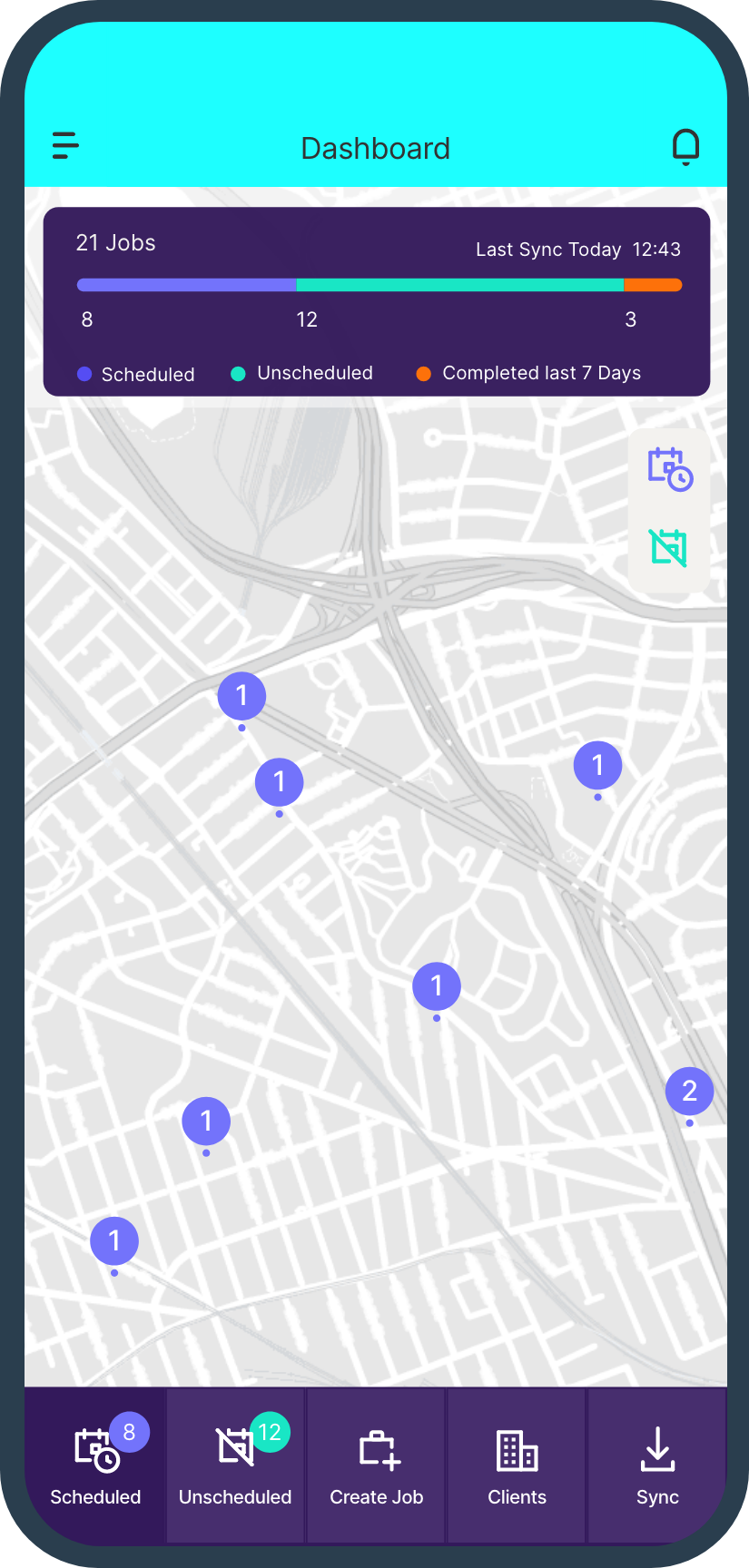Workflow optimisation, a term you may have heard and wondered what exactly does it mean? In particular what does it mean in the work of field service. Optimising your field service workflow involves enhancing and streamlining the processes and activities related to providing services in the field. This includes making improvements to scheduling, dispatching, communication, task execution, and overall operational efficiency. The goal is to maximise productivity, reduce costs, and enhance the overall quality of service delivery in a field service setting. This optimisation often involves the use of technology, automation, and strategic planning to achieve better outcomes for both the service providers and their clients.
How do you currently manage jobs and customers in your field service business?
In the dynamic landscape of field service operations, the key to sustained success lies in the continuous refinement and optimisation of workflows. Initiating the optimisation of field service workflows commences with conducting a thorough audit of your existing infrastructure and assessing its functionality. This initial step involves evaluating the current state of operations to identify areas that can be enhanced for improved efficiency. By scrutinising the existing processes and systems, your field service business can lay the groundwork for identifying opportunities for improvement and implementing strategic enhancements.
Creating an audit for optimising field service workflows is a strategic initiative that empowers organisations to enhance efficiency, reduce costs, and elevate the overall quality of service delivery. By systematically evaluating and fine-tuning the various components of field service management, businesses can identify bottlenecks, streamline processes, and leverage technology to stay ahead in an ever-evolving market. This guide delves into the essential steps and considerations involved in crafting an effective audit tailored to unlock the full potential of field service operations. Whether you’re a seasoned industry professional or just embarking on the journey of field service optimisation, this comprehensive approach aims to guide you towards creating a robust audit framework for sustainable and impactful improvements in your field service workflows.
6 essential steps and considerations required to craft an effective audit
Understanding the Landscape
Before embarking on the audit journey, it is crucial to comprehend the unique landscape of field service operations. This encompasses a wide array of activities, from scheduling and dispatching to on-site task execution. By gaining a comprehensive understanding of the operational ecosystem, organisations can pinpoint areas of strength and weakness, laying the foundation for targeted improvements.
1. Initiating the Audit
The first step in this transformative process is initiating the audit itself. This involves a meticulous examination of the current state of field service workflows. Organisations need to assess the effectiveness of existing processes, the utilisation of resources, and the overall efficiency of task execution. Through this introspective analysis, potential bottlenecks and areas for improvement come to light.
2. Identifying Improvement Opportunities
An effective audit goes beyond mere assessment; it is a proactive exploration of improvement opportunities. This phase involves scrutinising each facet of field service operations to identify areas where efficiency can be heightened, costs reduced, and customer satisfaction elevated. By leveraging technology, automation, and best practices, organisations can uncover untapped potential for optimisation.
3. Tailoring Solutions to Unique Needs
No two organisations are identical, and recognising this diversity is pivotal in the audit process. Tailoring solutions to meet the unique needs and challenges of a specific organisation ensures that the optimisation strategies are not only effective but also sustainable. This customised approach allows businesses to address their specific pain points and leverage their strengths.
4. Implementing Strategic Enhancements
Identifying improvement opportunities is just the beginning; the real impact comes from implementing strategic enhancements. Whether it’s adopting cutting-edge field service management software, refining communication protocols, or optimising resource allocation, the audit serves as a compass guiding organisations towards practical and impactful changes.
5. Embracing Technology and Innovation
In the modern era, technology plays a central role in field service optimisation. The audit process provides a platform to evaluate the integration of innovative solutions such as mobile applications, GPS tracking, and data analytics. Embracing technology not only enhances operational efficiency but also positions organisations at the forefront of industry trends.
6. Measuring and Iterating
An effective audit is an ongoing process that doesn’t conclude with implementation. Continuous measurement and iteration are essential components of a successful optimization strategy. By establishing key performance indicators (KPIs) and regularly assessing progress, organisations can adapt to evolving challenges and ensure sustained improvement.
In conclusion, crafting an effective audit tailored to unlock the full potential of field service operations is a strategic imperative for organisations seeking to thrive in a competitive environment. By understanding the landscape, initiating a comprehensive audit, identifying improvement opportunities, tailoring solutions, implementing enhancements, embracing technology, and adopting a mindset of continuous improvement, businesses can navigate the complexities of field service operations with finesse. This guide serves as a roadmap for organizations committed to elevating their field service workflows to new heights of efficiency and excellence.
Field service workflow automation should be a consideration
Field service workflow automation, commonly known as automating field service processes, involves the utilisation of software and management tools to streamline and automate routine and time-consuming tasks. In essence, this approach aims to enhance staff efficiency, boost productivity, and allocate more time to tasks of higher value. Take, for instance, the time-consuming building maintenance responsibilities such as organising data from incoming emails, scheduling, and creating work orders. Similarly, communication with customers and staff members becomes more time-consuming when job details undergo changes. Nevertheless, by implementing workflow automation, teams can significantly improve efficiency, allowing for a greater focus on tasks that deliver higher value.
Advantages of implementing workflow automation in your field service operations
Automating your field service workflows goes beyond merely improving team efficiency; it encompasses a range of additional benefits. There are several compelling advantages to implementing workflow automation in your field service operations. Consider the advantages such as elevated customer service, enhanced capacity to broaden your service offerings, and improved management of cash flow.
1. Enhanced Efficiency
Automation streamlines and accelerates routine tasks, reducing manual effort and minimizing delays. This leads to faster response times and improved overall operational efficiency.
2. Increased Productivity
By automating repetitive processes, your team can allocate more time and energy to tasks that require creativity, problem-solving, and strategic thinking. This boost in productivity contributes to accomplishing more in less time.
3. Improved Accuracy
Automation reduces the risk of human error, ensuring that data entry, scheduling, and other critical tasks are executed with precision. This can lead to higher service quality and customer satisfaction.
4. Real-time Monitoring and Reporting
Automated systems provide real-time visibility into field service activities. This allows for better monitoring of ongoing tasks, quicker decision-making, and the ability to generate comprehensive reports for performance analysis.
5. Optimised Resource Allocation
Automation helps in efficiently assigning and managing resources, including field technicians, equipment, and inventory. This optimization ensures that resources are utilized effectively, reducing unnecessary costs.
6. Enhanced Communication
Automated communication tools streamline interactions between field technicians, dispatchers, and customers. This leads to improved coordination, reduced miscommunication, and better customer service.
7. Faster Invoicing and Billing
Automation in work order management accelerates invoicing and billing processes. This not only speeds up the revenue cycle but also enhances financial transparency and accuracy.
8. Adaptability to Changes
Automated systems are often more flexible and adaptable to changes in schedules, priorities, or customer requirements. This agility is crucial in dynamic field service environments.
9. Cost Savings
Through improved efficiency, reduced errors, and optimized resource utilization, workflow automation contributes to cost savings. This is particularly beneficial in terms of fuel costs, labor hours, and overall operational expenses.
10. Customer Satisfaction
The combination of faster response times, accurate service delivery, and improved communication leads to heightened customer satisfaction. Satisfied customers are more likely to become loyal, repeat clients and advocates for your services.
Summary
The advantages of optimising your field service workflow and implementing workflow automation in field service operations extends beyond operational efficiency to impact various aspects of the business positively. From enhanced accuracy and productivity to improved customer satisfaction and cost savings, the transformative effects of automation contribute to a more agile and competitive field service ecosystem.


